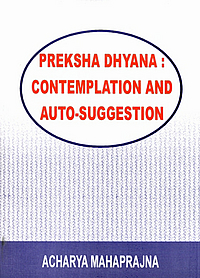 | About: |
Introduction The objective of meditation is not to acquire physical goodness alone, but to acquire total psychical goodness by eradicating all evil from one's thoughts, speech and action. It is a "process of remedying inner incompleteness and reducing inner discord" as aptly stated by William James.
To achieve this objective, the system of Preksā Dhyāna bifurcates into (a) Concentration of Perception and (b) Concentration of Thought Le. Preksā and anupreksā In the former technique of meditation, perception and awareness are primarily used for concentration; thinking is considered a distraction and is banished as far as possible. In the latter technique, the conscious mind is encouraged to engage itself in a ‘thinking process’ i.e. contemplation. Perception and contemplation both awaken and develop practitioner's conscious reasoning and thereby modify one's attitude and behaviour. Contemplation is, sometimes, defined as 'religious' meditation which is non-discursive (i.e. intuitive) and mostly mystical But in Preksā Dhyāna, contemplation is both discursive as well as intuitive. It means, research and deliberate reflection for Truth and Reality. Just as impartial (without like or dislike), objective and concentrated perception is meditation, a totally impartial and objective contemplation bereft of subjective prejudices and emotions is also meditation. Contemplation, therefore, is search for truth by a single-point mental faculty engaged in reflecting upon the reality, eliminating all that is mere appearance or illusion. It consists in concentrating on the entire mental faculty in searching Truth and nothing else.
The process of contemplation banishes all memories, eliminates all ideas and conceptions except one. Full concentration on a single mental conception becomes contemplative meditation and this is an efficient process of ascertaining the reality. It, therefore, becomes a powerful tool for realising the Truth. Whenever one concentrates on a theme or a object and takes a purely objective view, that banishes all subjective considerations, acuity of his cognition increases manifold. One, then, realises the true meaning of the theme or the true nature of the object Ancient philosophers and seers used this tools extensively for realising the Truth. Modern science also uses this process to ascertain the ultimate structure of the material universe.
In practice of contemplation the exercise is two-fold: (a) exercise of concentration, contemplation and reflection on a single theme and (b) exercise using auto-suggestion to effect attitudinal change. Contemplation of eternal truth such as "transitorinesś" comprise the first irrational fear by auto-suggestion is an example of the second type. Relaxation and the steadiness of body are essential pre-conditions in both types of exercise.
| |
| Author: | Acharya Mahaprajna |
| Publisher: | Jain Vishwa Bharati, Ladnun, India |
| Editor: | Muni Mahendra Kumar |
| Translators: | Muni Mahendra Kumar, Jethalal S. Zaveri |
| Edition: | Second Edition, 2009 |
| Read online: | Preksha Dhyana: Contemplation and Auto-suggestion |
| Bookshop: | Preksha Dhyana: Contemplation and Auto-suggestion |
| Pages: | 34 |
| Dimensions: | 13.90 x 21.50 x 0.20 cm (W x H x D) |
| Weight: | 55 g |